
The McDonald's Sign, also known as McDonald's Store #433 Sign, in Pine Bluff, Arkansas, United States, is one of only a few surviving examples of a single-arch McDonald's sign. The sign was erected in 1962 and remained at its original location until 2007. That year, McDonald's Store #433 moved and the sign was renovated and moved to the new location. The McDonald's sign was added to the U.S. National Register of Historic Places in 2006.

The Community Theatre is a historic theatre building at 207 West 2nd Avenue in Pine Bluff, Arkansas. It is a two-story brick building, finished in stucco, with Moderne styling. It was built in 1889, and housed first a furniture store, and then a five and dime, before being converted for theatrical use in the 1920s. Its present Moderne styling dates to renovations made in the wake of a 1951 fire.

New Edinburg is an unincorporated census-designated place in Cleveland County, Arkansas, United States. Per the 2020 census, the population was 134.
The University of Arkansas Campus Historic District is a historic district that was listed on the National Register of Historic Places on September 23, 2009. The district covers the historic core of the University of Arkansas campus, including 25 buildings.
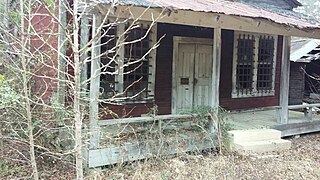
The Holt–Poindexter Store Building is a historic retail building in rural Ouachita County, Arkansas. It is located on County Road 101, near its southern junction with County Road 111, about four miles (6.4 km) north of Stephens, in the unincorporated community of Ogemaw. The store, a vernacular single-story wood-frame structure with a gable roof and full-width front porch, was built in 1904 by Curtis Smith, a local carpenter, for H. B. Holt, and is believed to be the oldest general store in southern Arkansas. A small addition was added to the north side in the 1920s to house post office facilities. This was removed in 1948, at which time a rear addition was added to provide space for an office and feed storage. The business was taken over by Holt's son-in-law, Chester Poindexter, and then his son, Kenneth.

The Jones General Store and Esso Station is a historic Esso automotive service station and general store on Arkansas Highway 84 in Langley, Arkansas. It is a single-story structure built out of fieldstone, with concrete door and window lintels. The car porch extends in front of the building, supported by three fieldstone columns topped by simple capitals. It was built in 1939, and served as the town's general store, operated by Johnny Jones, until the 1980s, when the store closed and the building was converted to residential use. The building is locally significant in part for a circular millstone, used in the town's first gristmill, which is embedded in the wall near the eastern corner.

The Anderson–Hobson Mercantile Store is a historic commercial building at 201 Schuman Street in Foreman, Arkansas. It is a three-story brick structure with modest Italianate styling, mainly visible in brick corbelling details and segmented-arch window crowns. It was built c. 1910, as part of a major growth spurt in the county following the arrival of the railroad. It is one of the few commercial buildings in the county to survive from that period.

The Kress Building is a historic commercial building at 210 West Main Street in Blytheville, Arkansas. It is a two-story concrete and steel structure, faced in brick and terra cotta. The building is the home of the Delta Gateway Museum, which interprets the history of the city of Blytheville and the surrounding area.

The Oak Hill Mausoleum, now Oak Hill Chapel, is a historic religious and funerary building in Oak Hill Cemetery, the oldest cemetery in Siloam Springs, Arkansas.

The Springdale Poultry Industry Historic District encompasses a small complex of commercial industrial buildings associated with the poultry industry in Springdale, Arkansas. Its three buildings included the original headquarters building of Tyson Foods, one of the world's largest producers of chicken meat. That building, at 319 East Emma Avenue, was built between 1914 and 1924 to house a produce store, and was extensively altered in 1947 to house the Tyson offices. Immediately adjacent at 317 East Emma is a chicken hatchery, built in 1924 by the Springdale Electric Hatchery Company and renamed the Jeff Brown Hatchery in 1949. The Tyson Feed Mill building stands behind these at 316 East Meadow. Jeff Brown was the first president of the Arkansas Poultry Improvement Association.
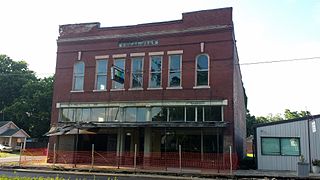
The Bondi Brothers Store is a historic commercial building at 104 Madison Street in downtown Clarendon, Arkansas. It is a two-story brick building, with modest Italianate styling. Its storefront has been altered to have plate glass over much of the front, but the recessed entrance remains, with an original transom window. The store was built in 1904 by Ike and Ed Bondi, sons of German immigrants who established a successful clothing store.

The Doe Branch Post Office is a historic house and post office in rural western Pulaski County, Arkansas. Located on the north side of Kanis Road, just west of its junction with Golden Eagle Drive, it is an L-shaped single-story structure built in a sequence of steps. The oldest portion is a single-pen board-and-batten structure, built in 1890 by Noah Richards. To this were added a clapboard addition to the side, a porch to the rear, and a kitchen, also to the rear, giving the building its present L shape. The building is one of the oldest in the Ferndale area, which was originally known as Doe Run, and was occupied by two generations of the Richards family.

The Campbell Post Office–Kuykendall General Store is a historic residential–commercial building in rural Searcy County, Arkansas. It is located on County Road 73, northwest of Oxley, Arkansas. It is a single-story wood-frame structure with modest Greek Revival styling. Its construction date was long thought to be 1920, but it was more likely built around 1900, still an extremely late date for the Greek Revival. It was converted into a post office and general store in the 1920s by Henry Kuykendall.
Hankins' Store is a historic commercial building at Ferry Road and Main Street in Oil Trough, Arkansas. It is a single-story wood-frame structure, built out of local cypress lumber, with a gable roof and clapboard siding that is original to its 1904 construction. An open porch extends across its front. The store stands near the White River Slough, a former course of the White River. It served the local community for almost exactly 100 years, closing in 2004, and typifies early 20th-century general stores.

The Jasper Commercial Historic District encompasses the historic commercial center of Jasper, Arkansas. It includes the Newton County Courthouse, a 1930s Works Progress Administration building, and buildings that line the courthouse square, as well as some of the streets radiating from it. Built between the 1880s and 1940s, the district includes a high quality collection of commercial buildings constructed out of local stone. Most are one or two stories in height, and are vernacular to the period of their construction. Five of the district's 26 buildings were built by Gould Jones, a prominent local blacksmith and mason.
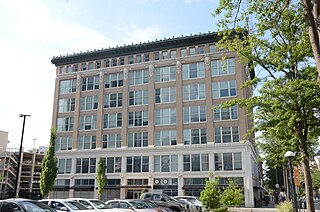
The Gus Blass Department Store is a historic commercial building at 318-324 Main Street in Little Rock, Arkansas. It is a seven-story masonry structure, built in 1912 to a design by George R. Mann, a leading Arkansas architect. It was one of the first instances of two-way concrete slab construction in the nation, and was one of the first department stores in the state to be air conditioned. The Blass Department Store was for many years the city's largest department store, and remained in business here into the 1970s, ultimately becoming a part of the Dillard's department store chain before closing in 1972.
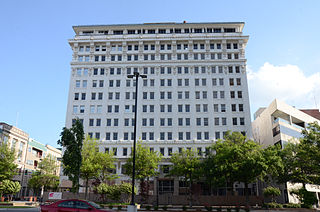
The Capitol–Main Historic District encompasses a well-preserved area of early 19th-century commercial architecture in downtown Little Rock, Arkansas. The district includes 2-1/2 blocks of Capitol Street, extending east from Center Street, one block of Main Street south of Capitol, and one block of 6th Street west of Main. The buildings in this area were mostly built before World War II, and are of a more modest scale than modern sections of the downtown. Notable buildings include the LaFayette Hotel and the Pfeifer Brothers Department Store.

The Matthews-Bryan House is a historic house at 320 Dooley Road, North Little Rock, Arkansas. It is a two-story masonry structure, built in the English Revival style in 1930 by the Justin Matthews Corporation as part of its Park Hill development. It has a steeply pitched gable roof, with cross-gabled entrance, and is faced in stone and brick. It was designed by Matthews Company architect Frank Carmean, and was one of the last houses built by Matthews before the full effects of the Great Depression affected his building style. As with most of Frank Carmean's homes, there are arches throughout and a full sized guest house in the rear.

The Woodrow Store is a historic commercial building on Arkansas Highway 263 in rural northern Cleburne County, Arkansas. It is a modest single-story wood-frame building, set on the south side of the highway in the crossroads community of Woodrow. Built in 1927, it served as the only general store and automobile fuel service station for the isolated hill community for many years.
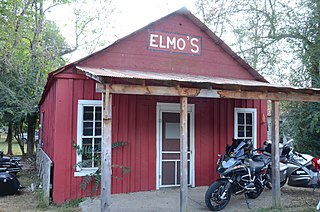
The N.E. Dickerson Store is a historic commercial building on Arkansas Highway 215 in the village of Oark, Arkansas, just west of the Oark General Store. It is a single-story wood-frame building, with a gabled roof and a shed-roof porch extending across the front. The front is three bays, with sash windows flanking the entrance. It was built about 1902 to meet increased retail demand in the community, and operated in a cooperative arrangement with the Oark General Store. In the late 20th century, the buildings were both owned by the same family.




















